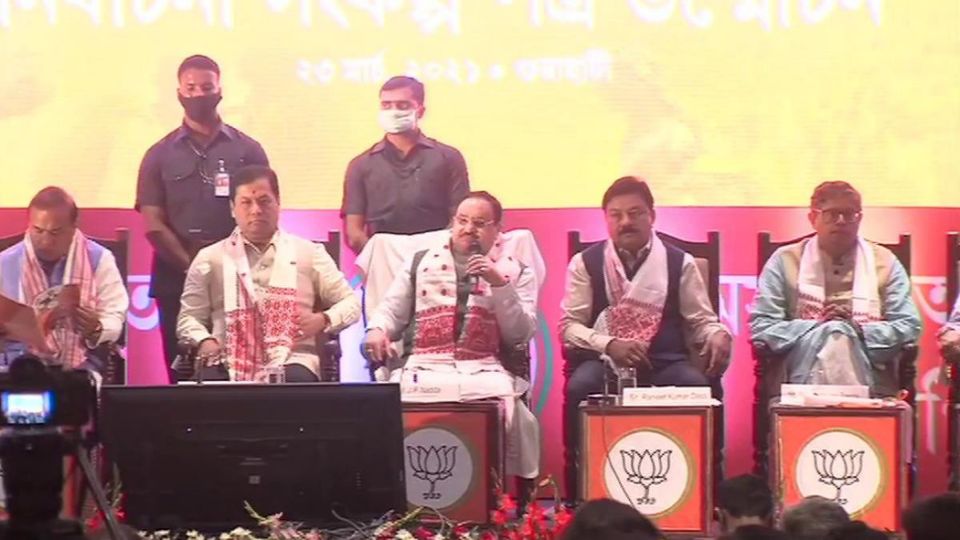Assam is headed for assembly elections from March 27 onwards. In this regard, BJP has released its party manifesto- named Sankalp Patra.
Some of the main points covered under the Sankalp Patra are as follows.
Corrected NRC:
The final Assam NRC, which was in works for six years, was published on August 31, 2019. It was immediately attacked by the BJP for excluding 19 lakh people, many of them Hindus, with party chief Ranjit Dass saying that the number was lower than earlier government estimates of illegal foreigners and among those kept out were “sons of the soil”.
Since then, the list has remained in a limbo, with those excluded yet to even receive rejection orders with which to appeal to Foreigners’ Tribunals. Unveiling the manifesto, BJP national president J P Nadda said, “We will protect genuine Indian citizens and detect illegal infiltrators so that Assam can remain Assam’s.”
No mention of CAA:
While BJP has been drum-beating about the CAA in the run-up to the election in the neighbouring state West Bengal, it has not mentioned the citizenship law in its Assam-manifesto. Asked about it, Nadda said that the CAA “would be implemented in letter and spirit”. However, the BJP perhaps believes that it can get away with this balancing act between Bengal and Assam with the CAA protests appearing to be a distant memory in Assam.
Jobs for youths
BJP has promised two lakh government jobs (1 lakh before March 31, 2022). Another ‘Sankalpa’, or resolve, is to make Assam India’s entrepreneurial hub. Ten lakh youth entrepreneurs are to be created through a Swami Vivekananda Asam Youth Employment Yojana. A survey by the Centre for Monitoring Indian Economy (CMIE) put Assam’s unemployment rate at a 19-month high of 11.1% in April 2020, rising from 0.7% in April 2016. However, the data also shows a sharp recovery post lockdown with unemployment down to 1.6 % in February 2021.
Protection of indigenous rights:
With suspicion still over the BJP’s CAA and its intentions over Clause 6 , the party has promised measures to protect the “Jaati, Maati and Bheti (Community, Home and Hearth)” of the indigenous people of Assam. They include a task force to check “illegal encroachment” on the land of sattras of Vaishnavite saint Srimanta Sankardeva, financial aid of Rs 2.5 lakh to all Naamghars (Vaishnavite worship halls) and places of worship of tribals, and distribution of pattas to all landless citizens. The party has also promised a delimitation exercise to “protect the political rights of the people”, indicating that constituencies might see a realignment to give indigenous communities more say.
Flood problem:
Governments have come and gone in the state, without solving Assam’s annual spectre of floods. The BJP talks of ‘Mission Brahmaputra’, to “finally” check this. The manifesto states, “We will approach it scientifically, build big reservoirs to collect water.” Dredging of the river from Dhubri (in western Assam) to Sadiya (in the east) was also announced. Even before it came to power in Assam, the BJP had proposed a plan to dredge the Brahmaputra, adding that it would use the resultant silt to build roads on either side of the river. However, experts have often said that this was an impractical solution simply because the Brahmaputra sediment yield is among the highest in the world. No amount of dredging can stop the river’s siltation.
Focus on Women :
With the largely woman-centric Orunudoi scheme being a huge hit, the party is set to enhance it. The dole for the DBT scheme will be increased from Rs 830 to Rs 3,000 per month, with 30 lakh families brought under it. The BJP clearly sees Orunudoi as a game-changer. Indian National Congress has responded by announcing a ‘Grihini Samman’ scheme, of Rs 2,000 per month to homemakers.
Silence over the issue of Clause 6:
In order to contain the widespread protests against the CAA, the Assam government had promised speedy implementation of Clause 6 of the Assam Accord, that promises to protect the interests of the “indigenous” people of Assam, and has appointed a high-level committee for the same. However, given its recommendations, made public by two-members panel, and the complications involved, the BJP has chosen silence as the better form of valour.
The first phase of Assam election is scheduled for March 27, where 47 constituencies will be voting. The second phase will see 39 constituencies voting on April 1. The final and third phase is on April 6 for the remaining 40 constituencies.
After the vote counting, results of the election will be announced on May 2, along with the results of the other 4 states – Kerala, Tamil Nadu, West Bengal & Puducherry.





